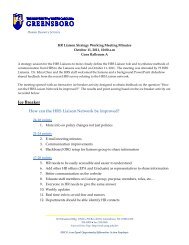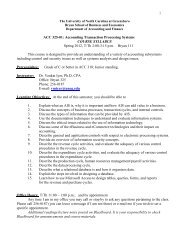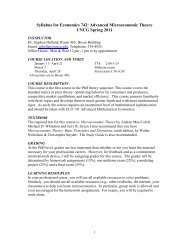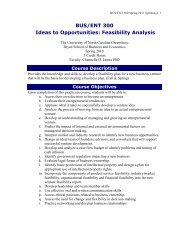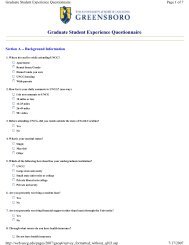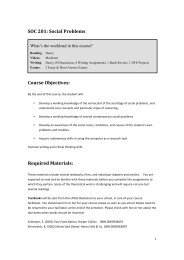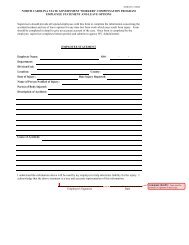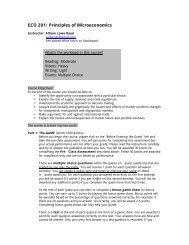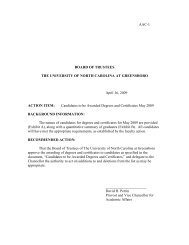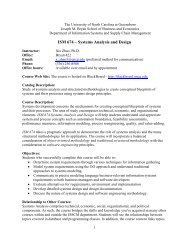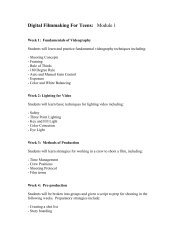Classification/Compensation Plan for Career Banding (.pdf)
Classification/Compensation Plan for Career Banding (.pdf)
Classification/Compensation Plan for Career Banding (.pdf)
You also want an ePaper? Increase the reach of your titles
YUMPU automatically turns print PDFs into web optimized ePapers that Google loves.
University of North Carolina at Greensboro<br />
<strong>Career</strong> <strong>Banding</strong> Salary Administration <strong>Plan</strong><br />
Effective October 1, 2007<br />
Revised January 22, 2009<br />
<strong>Compensation</strong> Philosophy<br />
It is the policy of the University of North Carolina at Greensboro to support and sustain a<br />
work environment which recognizes accomplishment and achievement. The career<br />
banding program is structured to ensure SPA employees receive fair and equitable<br />
treatment in regard to compensation levels and career development opportunities. The<br />
<strong>Career</strong> <strong>Banding</strong> <strong>Compensation</strong> Strategy policy and guidelines will be applied effectively<br />
and equitably <strong>for</strong> all eligible employees.<br />
The University’s goals oriented work environment supports compensation levels that: 1)<br />
are consistent with University priorities, 2) promote and reward successful work<br />
behavior, 3) recognize job competencies that are linked to organizational goals, 4)<br />
maintain appropriate labor market competitiveness to ensure effective recruitment and<br />
retention of a highly competent and diverse work <strong>for</strong>ce, and 5) are supportive of<br />
individual, family, and community values.<br />
<strong>Compensation</strong> Strategy<br />
UNCG’s career banding program allows employees to advance in their careers while<br />
supporting the university’s vision and strategic plan. The career banding program is<br />
competency based with compensation being labor market driven. As competencies are<br />
developed through education, training, and practical experience, employees become<br />
eligible <strong>for</strong> career progression adjustment (CPA) considerations. UNCG consistently<br />
applies the <strong>Career</strong> <strong>Banding</strong> Policy and <strong>Compensation</strong> Philosophy/Strategy <strong>Plan</strong> in order<br />
to ensure employees are compensated appropriately based on development of new or<br />
higher level competencies, employees’ contributions to their departments, and/or salary<br />
levels present in the appropriate labor market <strong>for</strong> comparable work, and the Universities’<br />
financial resources or ability to pay. The <strong>Career</strong> <strong>Banding</strong> program is designed to<br />
facilitate the development of competencies that will enable employees to advance in<br />
their careers as follows:<br />
• Facilitate increased employee satisfactions and reduce turnover;<br />
• Define and communicate the competencies needed <strong>for</strong> career advancement,<br />
and;<br />
• Ensure congruence between individual position expectations and the<br />
department’s per<strong>for</strong>mance expectations.
Human Resource Services Responsibilities<br />
The Employee Services Director serves as the <strong>Career</strong> <strong>Banding</strong> Administrator. The<br />
Administrator oversees the career banding program, ensuring that effective<br />
communication, training, evaluation, accountability, and equal opportunity are strong<br />
components.<br />
Human Resource Services (HRS) provides initial training to managers and supervisors<br />
in the respective job family being implemented. As changes occur with career banding<br />
and new managers are hired, HRS provides continued training to sustain the<br />
professional expertise of managers and supervisor to utilize this<br />
classification/compensation program. The Per<strong>for</strong>mance Management Program, PMP, is<br />
utilized to ensure that managers and supervisors are accountable <strong>for</strong> providing career<br />
development advice/guidance and that they are consistently applying the Pay Factors<br />
equitably in making compensation decisions. This responsibility should be noted on the<br />
supervisor’s work plan as a job expectation. Initially HRS and managers/supervisors<br />
jointly determine compensation decisions. Following implementation, requests <strong>for</strong><br />
granting reclassifications or CPA are <strong>for</strong>warded to the HR Program Managers <strong>for</strong> final<br />
approval. HR Program Managers are Human Resource Consultants who service their<br />
assigned departments. They oversee all HR related activity within their assigned<br />
departments, including the approval of career banding change requests. Any<br />
questionable action is routed by the HR Program Manager to the <strong>Career</strong> <strong>Banding</strong><br />
Administrator <strong>for</strong> approval. If a pattern of questionable actions surfaces, the HR<br />
Program Manager and the <strong>Career</strong> <strong>Banding</strong> Administrator will counsel with the<br />
manager/supervisor involved to deter continued policy discrepancies. Following<br />
counsel, if inappropriate recommendations/requests continue, HRS will facilitate the<br />
salary adjustments in the department/division until such time as the process can be<br />
reassigned. This HR Program Manager oversight will allow <strong>for</strong> an equitable campuswide<br />
application of Pay Factors in determining salary adjustments and is in line with<br />
delegated authority from the Office of State Personnel via signed Memoranda of<br />
Understanding. HRS provides guidelines/parameters to the respective department(s)<br />
on what percentages of salary increases are appropriate. Salary adjustments to be<br />
recommended or awarded may not exceed the maximum of the band. HRS conducts<br />
annual self-assessments of the career banding program including, but not limited to the<br />
following:<br />
• Tracking dispute resolution decisions resulting from career banding salary<br />
adjustment decisions;<br />
• Determining if the career banding concept has been provided in writing to<br />
employees;<br />
• Determining if Pay Factors have been applied consistently in compliance with<br />
the plan;<br />
• Determining if employees have been provided opportunities <strong>for</strong> development<br />
and advancement; and,<br />
• Ensuring that the department(s) does not engage in unlawful discrimination.<br />
HRS reports results of the program self-assessments to the Office of State Personnel<br />
(OSP) as requested.
Department Responsibilities<br />
Management will ensure that the principles of the career banding program are<br />
communicated to all employees. A focus group composed of a broad spectrum from the<br />
respective job family may be requested to assist HRS in communicating the career<br />
banding plan to other affected employees. HRS and the ad hoc focus group may<br />
develop training materials, and programs regarding that job family as needed. The<br />
department maintains copies of the all career banding documents. As new employees<br />
are hired, they will be briefed and receive the written material as part of the new<br />
employee orientation. Supervisors establish career development plans and provide<br />
employee coaching with a goal of enhancing each employee’s contribution to the<br />
organization’s success at the highest level allowed by the strategic plan. Supervisors<br />
evaluate employee’s competencies upon entrance into any career banded position to<br />
determine competency level. Thereafter employee competencies are evaluated during<br />
mid-year interim reviews and during the annual per<strong>for</strong>mance reviews when employees<br />
are in<strong>for</strong>med of any salary adjustment considerations. Departments apply Pay Factors<br />
as listed below. To ensure available funds are distributed fairly and equitably, salaries<br />
are determined in compliance with the State Personnel <strong>Career</strong> <strong>Banding</strong> Salary<br />
Administration Policy. Pay factor evaluation occurs with each action as defined in<br />
policy: New Hire, Promotion, Reassignment, Horizontal Transfer, Demotion, etc.<br />
Following are the four Pay Factors:<br />
• Financial Resources (ability to pay)<br />
• Appropriate Market Rate<br />
• Internal Pay Alignment (equity considerations <strong>for</strong> like positions)<br />
• Required Competencies<br />
Pay factor evaluation also occurs with the following situations to determine if a <strong>Career</strong><br />
Progression Adjustment (CPA) may be warranted:<br />
• Attainment and demonstrated use of competencies or skills within the same<br />
class<br />
• Acquisition of additional or different duties within the same class<br />
• Recognition of low employee salaries in relation to average market rate or<br />
market reference rate.<br />
The department(s) also provides documentation (competency assessment <strong>for</strong>m) <strong>for</strong><br />
each salary decision. A salary adjustment decision is defined as a manager’s<br />
determination of the amount of pay that an employee will be granted after applying the<br />
pay factors in any situation.<br />
E mployee Responsibilities<br />
Employees, in conjunction with supervisors, review work plans to ensure an<br />
understanding of their relevance of competencies and work functions to the mission and<br />
goal of the Department/Division/University. Employees attend meetings, in<strong>for</strong>mation<br />
sessions, etc. that provide explanation of the career banding program. Employees
assume the responsibility <strong>for</strong> following the dispute resolution process, which begins with<br />
direct notification to the immediate supervisor and then may proceed through the chain<br />
of supervision, if needed. (Specific procedural instructions are provided on the <strong>Career</strong><br />
<strong>Banding</strong> Dispute Resolution Form, HRCB 210, defining the process and time<br />
limitations.)<br />
D ispute Resolution Process<br />
The dispute resolution process allows employees to have salary adjustments and<br />
placement decisions reconsidered by a source beyond the initial decision-maker. Any<br />
disputes resulting from career banding are tracked and independently reviewed by a<br />
<strong>Career</strong> <strong>Banding</strong> Dispute Committee that has been established representative of all<br />
divisions. UNCG’s <strong>Career</strong> <strong>Banding</strong> Dispute Committee consists of: The UNCG <strong>Career</strong><br />
<strong>Banding</strong> Administrator (Chair); two Human Resource Services Program Managers or<br />
designee; and two members of the UNCG <strong>Career</strong> <strong>Banding</strong> Advisory Committee who are<br />
not in the same department as the employee filing a dispute. Decisions, which are<br />
eligible <strong>for</strong> reconsideration under this plan, must be based on one of the following:<br />
• Amount of salary adjustment is different from expected based on application<br />
of the pay factors<br />
• No salary adjustment has been granted when application of pay factors would<br />
support an adjustment<br />
• Assignment within the band is different than expected based on employee’s<br />
competencies compared to the position description<br />
Salary decisions based on financial resources (ability to pay) are not eligible <strong>for</strong><br />
consideration in the dispute resolution process. Refer to <strong>Career</strong> <strong>Banding</strong> Resolution<br />
Form, HRCB-210, <strong>for</strong> process and timing instructions.<br />
Disputes must be filed within 30 days or the original salary decision notification and<br />
must be resolved within 60 days after dispute is received in HRS.<br />
C areer <strong>Banding</strong> Advisory Committee (CBAC)<br />
An employee advisory committee, representative of a diverse population based on<br />
organizational demographics, hierarchical level, and current positions, assesses and<br />
evaluates the operation of the career banding program, as requested, and offers advice<br />
and counsel regarding the program’s effectiveness, efficiency, and equity. Results will<br />
be shared with the <strong>Career</strong> <strong>Banding</strong> Program Administrator and others as appropriate.<br />
UNC Greensboro has a <strong>Career</strong> <strong>Banding</strong> Advisory Group <strong>for</strong> the purpose of adding<br />
dimension and a system of checks and balances to the <strong>Career</strong> <strong>Banding</strong> program. This<br />
is a group of approximately twelve members who have broad experience, understand<br />
the structure of the university and its mission and goals, and represents all divisions<br />
within the University. The CABC is aware of trends, practices and issues related to their<br />
divisions and the effects of those factors on <strong>Career</strong> <strong>Banding</strong>. They are a bridge between<br />
the rank and file employee and management. Because of their positions and placement<br />
within the organization, they are able to operate on the big picture scale as well as<br />
exercising sensitivity to issues regarding individual employees. UNCG uses the CBAC<br />
in the following ways:
• Job Family Profiles are presented to this group <strong>for</strong> input prior to being taken<br />
to focus groups.<br />
• to provide input into the composition of focus groups<br />
• to provide input into possible issues regarding a particular Job Family<br />
• to provide advice on requested band/level changes during an implementation<br />
• to provide ongoing input into CB issues/trends<br />
• to serve on the Dispute Resolution Committee when disputes are filed.<br />
Members provide guidance to their respective departments/division concerning policy<br />
interpretation provided by HR; scheduling of departmental deadlines to meet HR<br />
deadlines during implementation<br />
As change occurs in CB policy, that in<strong>for</strong>mation is disseminated to the CB Advisory<br />
Group to apply in guiding their respective areas<br />
Im plementation of a New Job Family Guidelines<br />
Upon implementation of a new job family, an overview of this plan will be presented to<br />
all affected staff during <strong>for</strong>mal group meetings. Additionally, all supervisors and<br />
managers will be requested to attend training conducted by HRS on how to administer<br />
the new job family. Initially, management within the job family, in collaboration with<br />
HRS, assigns all affected employees to the appropriate band based on current<br />
classification and role. Further determinations are then made specific to each employee<br />
based on their appropriate competency level (contributing, journey and advanced) and<br />
their appropriate salary as determined by the Pay Factors. Following implementation,<br />
each individual employee’s development of competencies, completion of training, and<br />
demonstration of applicable knowledge, skill and abilities will be used to determine<br />
appropriate classification and/or career development plans. HRS will continue to<br />
provide consultation to managers and supervisors as needed to ensure success of the<br />
program.<br />
C ompensation <strong>Plan</strong><br />
As job families are implemented, UNCG accepts the market rates <strong>for</strong> job families as<br />
established by the office of state personnel (OSP). The journey market rate will be the<br />
goal of the university compensation plan based on similar factor analysis; ability to pay,<br />
current market trends, internal pay alignment, and complexity of required competencies<br />
assessed against the competency level of the employee. Any deviation from those<br />
factors may affect the target rate of the employee, level, band, branch or job family.<br />
Market Reference Rates set by OSP and the frequency of updating those rates and<br />
volatility of the labor market may also affect the ability of the University to achieve its<br />
goal of parity with market.<br />
Current Employees: After initial band and competency level designation, employees<br />
are considered <strong>for</strong> future salary adjustments based on advancement/achievement. An<br />
evaluation of competencies occurs during the interim and annual appraisal periods.
Supervisors may approve salary adjustments (CPA) up to the market rate of the<br />
position. Salary adjustments in excess of the market rate require approval of the<br />
division head and concurrence by HRS and may require approval of OSP. Salary<br />
adjustments many not exceed the maximum of the pay band <strong>for</strong> any reason. Requests<br />
to take an employee’s salary above the market rate require appropriate written<br />
justification which must accompany the request <strong>for</strong> approval. Justification may include<br />
but is not limited to the following: development of higher level competencies, attainment<br />
of additional knowledge and skills, job change, and/or internal equity concerns. Any<br />
salary adjustments exceeding the “halo” (market rate plus 10%) may be <strong>for</strong>warded to<br />
OSP along with justification <strong>for</strong> approval. A salary adjustment <strong>for</strong> any reason (example:<br />
new hire, promotion, <strong>Career</strong> Progression Adjustment, reclassifications, etc.) that exceed<br />
20% higher than current salary, must be <strong>for</strong>warded with appropriate justification to OSP<br />
<strong>for</strong> approval. If a CPA is to be effective July 1, any legislative increase (LI) is applied<br />
be<strong>for</strong>e the CPA. Banded market rates may change at any time based on approved LI<br />
and/or on market data approved by the Office of State Personnel.<br />
New Hires:<br />
New employees possessing the minimum qualifications and competencies at the<br />
contributing level shall normally be paid at the minimum of the contributing band within<br />
the banded class. If the new employee possesses competencies and qualifications that<br />
are above the minimum standards, the salary may be established at a higher rate within<br />
the range assigned to the band and level. The pay factors, as stated in the plan, will be<br />
considered in determining the new employee’s salary. New hires who do not meet the<br />
minimum qualifications and competencies <strong>for</strong> the contributing level will be compensated<br />
below the contributing market reference rate.<br />
Probationary Adjustments:<br />
Employees may be considered <strong>for</strong> salary adjustments at the successful completion of<br />
probation based on increased competency levels. After permanent status is awarded,<br />
consideration <strong>for</strong> adjustments will follow the schedule <strong>for</strong> current employees (mid year<br />
and end of year).<br />
Promotions:<br />
Promotions will be awarded through a competitive process to include posting of the<br />
vacancy, interview, and <strong>for</strong>mal assessment procedures. If employees are promoted<br />
from a lower band to a higher band, they may be awarded a minimum of 5% on their<br />
current salary and must be paid at least at the minimum of the competency pay range<br />
<strong>for</strong> their new position if funds are available. If funds are not available, an increase may<br />
be considered at a later date based on a future evaluation of the pay factors. The future<br />
adjustment must be made on a current basis, not retroactive. Salaries will be<br />
determined based on the Pay Factors and may not exceed the maximum of the range.<br />
Reassignment to a Lower Band or Level:<br />
If an employee moves from a higher band to a lower band or from a higher pay level to<br />
a lower pay level within a band, the move may be considered a reassignment or a<br />
demotion. If the move is due to poor per<strong>for</strong>mance, the move is considered a demotion<br />
and normal demotion salary policies apply. The salary may be reduced to any amount<br />
within the pay range established <strong>for</strong> the lower band and level or it may remain the same<br />
except that the salary may not exceed the maximum of the lower pay range. For
definitions of Reassignment and Demotion, refer to the definitions at the end of this<br />
plan.<br />
<strong>Career</strong> Progression Adjustment – Advancement (within level or band salary<br />
adjustment):<br />
Advancement through the pay band is a non-competitive process. Salary adjustments<br />
may be awarded (but are not mandatory) to recognize progression through the<br />
competency structure, the assumption of additional duties and responsibilities, and/or<br />
market factors. Salary adjustments above the market rate must be justified based on<br />
competencies, knowledge, skills, abilities, and magnitude of job change, internal equity,<br />
market conditions, and other relevant factors. Salary increases up to the market rate of<br />
the position do not require written justification.<br />
Pay <strong>Plan</strong> Change (Transfer):<br />
If an employee transfers from a classification with a salary grade to a banded<br />
classification, a salary adjustment may or may not be awarded. The appropriate salary<br />
level <strong>for</strong> the individual will be determined by evaluating the employee’s current grade<br />
with the comparable roles and/or competencies of the banded positions. If it is<br />
determined that the new position is a higher grade, a salary adjustment may be<br />
awarded. The amount of the increase will be determined in the same manner as a<br />
promotion. Salary adjustment is not mandatory. If it is determined that the current<br />
graded position and the new banded position are at comparable or lower classification<br />
roles and/or competencies levels, no increase will be awarded unless an exception is<br />
approved by OSP.<br />
In Range Adjustments:<br />
The <strong>Career</strong> <strong>Banding</strong> Program replaces the need <strong>for</strong> in-range adjustments.<br />
Processing Actions:<br />
The department and HRS will process salary adjustments using the system action<br />
reasons and codes designated by OSP.<br />
Market Data:<br />
The labor market <strong>for</strong> statewide job family bands will be established by the Office of<br />
State Personnel using data from applicable salary survey(s). Geographic specific labor<br />
market data from the applicable salary survey(s) will be used <strong>for</strong> the setting of the<br />
Contributing, Journey and Advanced rates <strong>for</strong> the university. This will include viable<br />
recruitment areas as well as areas with which we experience strong competition<br />
Definitions<br />
Competencies: Knowledge, skills and work behaviors that contribute to success in the<br />
job and to the organization’s mission and goals...<br />
Contributing Competencies: The span of knowledge, skills and successful work<br />
behavior necessary to per<strong>for</strong>m a job from entry up to journey competencies required <strong>for</strong><br />
the class.
Journey Competencies: Fully applied body of knowledge, skills and successful work<br />
behavior demonstrated on the job, which is beyond the contributing competencies.<br />
Advanced Competencies: The highest or broadest scope of knowledge, skills, and<br />
work behavior demonstrated on the job, which are beyond journey competencies.<br />
Promotion: Movement of an employee through a competitive selection process, where<br />
the market rate of the new position is higher than the market rate of the current position.<br />
Horizontal Transfer: Employee movement from one position to another within the<br />
same banded classification with the same competency level or movement from one<br />
position to another with a different classification with the same market rate or within 5%<br />
of the employee’s current market rate.<br />
Reassignment: Employee movement from one position to another without a<br />
competitive selection process where the market rate of the current classification and<br />
new classification are within 5% of one another.<br />
Demotion: Disciplinary action, resulting in: (1) Employee movement from one banded<br />
position to another with the same banded classification with a lower market rate; (2)<br />
employee movement from one banded position to another with a different band<br />
classification with a lower market rate; or (3) reduction in salary within same banded<br />
class.<br />
<strong>Career</strong> Progression Adjustment: Salary adjustments awarded to recognize:<br />
• an employee’s progression through a pay range based on established<br />
competency structure;<br />
• assignment of additional duties and responsibilities; or<br />
• realignment of banded classification salary ranges approved by OSP based<br />
on market conditions.<br />
Journey Market Rate: The average salary of competitors in the relevant labor market<br />
<strong>for</strong> a banded class as determined by comparisons of benchmark jobs.<br />
Market Reference Rate: A market rate determined by comparing benchmark jobs to<br />
relevant local, state or national market data that allows geographical market flexibility in<br />
establishing appropriate market relationships.<br />
Pay Band: A broad pay range approved <strong>for</strong> use with the career banding program.<br />
These bands will include contributing, journey and advanced levels.<br />
Pay Range: The actual range of pay (minimum to maximum) assigned to a band.<br />
Banded <strong>Classification</strong> Series: A group of banded classifications that represents the<br />
full range of work per<strong>for</strong>med <strong>for</strong> entry level through the management level (i.e.<br />
Technology Support Technician, Technology Support Analyst, and Technology Support<br />
Specialist).
Banded <strong>Classification</strong>: A broadly defined class concept that incorporates related<br />
groups of graded classifications resulting in vertical and/or horizontal integration of<br />
work.<br />
<strong>Career</strong> Band Level Change: A change in the level to which an employee is assigned<br />
within a banded class.



